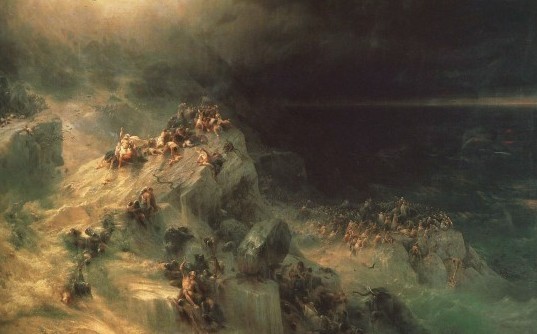Autobiographical notes appear here: William Whiston 1667- 1752

The years 1680 and 1682 were years of unusually bright comets. Many pamphlets were printed, especially in Germany, on the imminent end of the world; at the very least, great catastrophes were expected. This was nothing new. In earlier centuries and also earlier in the seventeenth century, comets were regarded with awe and every possible evil effect was ascribed to them.
A scholarly author, David Herlicius, published in 1619 a discourse on a comet that had appeared in 1618, and enumerated the calamities that this comet, and comets in general, bring with them: ”Desiccation of the crops and barrenness, pestilence, great stormy winds, great inundations, shipwrecks, defeat of armies or destruction of kingdoms . . . decease of great potentates and scholars, schisms and rifts in religion, etc. The portents of comets are threefold—in part natural, in part political, and in part theological.”
David Herlicius also quoted Cicero: “From the remotest remembrance of antiquity it is known that comets have always presaged disasters.”
The fear and even horror caused by the comet of 1680 was just beginning to calm down when in 1682 another great comet appeared.
Edmund Halley was twenty-six years old when this comet of 1682 appeared. He had experience in astronomical observations and calculations, having spent time on the island of St. Helena, cataloguing there 341 southern stars; he had observed the transit of Mercury, and made pendulum observations. Now he calculated the orbit of the comet of 1682, and predicted its return in 1759. Actually, the periodicity of comets was not first discovered by Halley. The ancient authors knew that comets have their time of revolution. Seneca wrote in his treatise De Cometis, in some respects still the most advanced discussion of this subject, that the Chaldeans counted the comets among the planets.
Nevertheless, only little aware of the works of the ancients, the modern world acclaimed Halley to be the discoverer of the periodicity of comets; however, this acclaim came only after the comet of 1682, or Halley’s comet, returned in 1759. It came somewhat retarded on account of its passage near the planets Jupiter and Saturn. This delay had been calculated, though not quite accurately, by Halley. On the grave of Halley these modest words are engraved: “Under this marble peacefully rests… Edmundus Halleius, LL.D., unquestionably the greatest astronomer of his age.”
But when Halley offered his theory of the periodicity of comets, and of the return of the observed comet after seventy-five years, this theory was not received immediately with enthusiasm. Yet in the mind of a contemporary mathematician the idea of a periodic return of comets was the beginning of a broadly-developed theory of the origin of the world and of the nature of the deluge.
William Whiston, born in 1667, published in 1696 his New Theory of the Earth. In this book he claimed that the comet of 1682 was of a 575 and half year periodicity; that the same comet had appeared in February of 1106, in 531, and in September of -44, the year of Caesar’s assassination. Whiston further asserted that this comet had met the earth in -2346, and caused the Deluge.
Whiston found in classical literature references to the change in inclination of the terrestrial axis and, ascribing it to a displacement of the poles by the comet of the Deluge, concluded that before this catastrophe the planes of daily rotation and yearly revolution coincided and that, therefore, there had been no seasons. He also found references to a year consisting of 360 days only, and although the Greek authors referred the change to the time of Atreus and Thyestes, and the Romans to the time of Numa, about -700, Whiston ascribed these changes to the effect of the Earth’s encounter with the comet of the Deluge. Whiston thought that the Earth itself was once a comet.
Whiston was chosen by Isaac Newton to take over his chair of mathematics at Trinity College in Cambridge when Newton, after many years, retired in order to dedicate himself to the duties of the president of the Royal Society. Whiston, like Newton, was a Unitarian. He was also close to being a fundamentalist. He was certain that only one global catastrophe was described in the Scripture, that of the Deluge. Of the phenomenon described in the book of Joshua, he wrote: “The Scripture did not intend to teach men philosophy, or accomodate itself to the true and Pythagoric system of the world.”

It is difficult to say what caused Newton, who selected Whiston as his successor, to oppose Whiston’s election to the membership of the Royal Society. We have another similar instance a century later, when Sir Humphry Davy, the mentor of Michael Faraday, conducted a strenuous campaign to keep Faraday from being admitted to the Royal Society, of which Davy was president.
But the very idea of a periodicity of comets, gleaned by Whiston from Halley, was not yet accepted. In 1744 a German author wrote: “It is well known that Whiston and others like him who wish to predict the comings and goings of comets, deceive themselves, and have become an object of ridicule by the entire world.” Nothing changes.
Still later Whiston was ridiculed by Georges Cuvier, himself a proponent of a catastrophist theory: “Whiston fancied that the earth was created from the atmosphere of one comet, and that it was deluged by the tail of another. The heat which remained from its first origin, in his opinion, excited the whole antediluvian population, men and animals, to sin, for which they were all drowned in the deluge, excepting the fish, whose passions were apparently less violent.”
Notes by Immanuel Velikovsky 1895-1979 Thanks to : http://www.varchive.org/